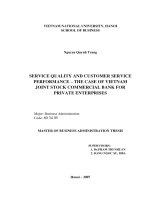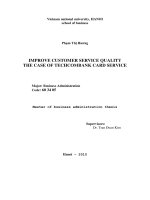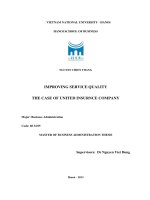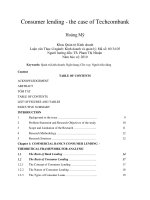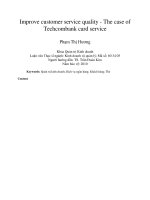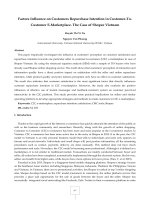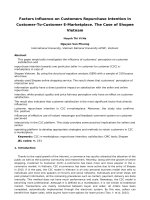Improve customer service quality - The case of Techcombank card service
Bạn đang xem bản rút gọn của tài liệu. Xem và tải ngay bản đầy đủ của tài liệu tại đây (1.42 MB, 101 trang )
Vietnam national university, HANOI
school of business
Phạm Thị Hương
IMPROVE CUSTOMER SERVICE QUALITY
THE CASE OF TECHCOMBANK CARD SERVICE
Major: Business Administration
Code: 60 34 05
Master of business administration thesis
Supervisors:
Dr. Tran Đoan Kim
Hanoi – 2010
vi
TABLE OF CONTENTS
ACKNOWLEDGEMENTS i
ABSTRACT ii
TÓM TẮT iv
TABLE OF CONTENTS vi
LIST OF TABLES ix
LIST OF FIGURES xi
INTRODUCTION 1
CHAPTER 1: LITERATURE REVIEW 3
1.1 Service marketing mix in banks. 4
1.1.1 Service marketing mix. 4
1.1.2 Service marketing mix in banks 6
1.2 Customer satisfaction. 11
1.2.1 Definition. 11
1.2.2 What determines customer satisfaction? 12
1.3 Service quality and GAP model. 13
CHAPTER 2: TECHCOMBANK CASE STUDY 25
2.1 Status of Techcombank and introduction of its card service 25
2.1.1 Techcombank Personal cards and card services. 25
2.1.1.1 Prospects of card in Vietnam market. 25
2.1.1.2 The strategy to develop card. 27
2.1.1.3 Some successes and ambituous plan of card development. 27
2.1.2 Card issuing, using and payment Processes and activities. 30
2.2 A review of Techcombank’s previous survey on card service: Customer
satisfaction on card services. 31
2.2.1 Survey objectives. 31
2.2.2 Sizes and methods: 32
2.2.2.1 Attendees and effective zone: 32
vii
2.2.2.2 Investigation methods: 32
2.2.3 Results. 34
2.2.3.1 Total samples and feedback percentages. 34
2.2.3.2 The specific Results of Customer satisfaction on card services of
Techcombank 35
2.3 Focus group and in depth-interview for updated status of customer service
quality. 41
2.3.1. Focus group 41
2.3.2 In depth-interview. 45
CHAPTER 3: FINDINGS 48
3.1 Customer GAP analysis. 48
3.2 Provider GAP analysis. 52
3.2.1. Failure in Providing in line with the standards and the designed services. 55
3.2.1.1. Failure to meet the technological requirements needed for the work 55
3.2.1.2 Failure in providing good consultancy to let the customers see which of
their needs are met and what they can request with the service. 63
3.2.1.3 Difficulties in quality management and assurance. 65
3.2.2 “Barking dogs seldom bite” (Inconsistency) in retail sales activities 68
3.2.3 The training for the customer service staff has not been paid proper
attention, resulting in poor quality in providing the consultancy to the customers,
and sometimes generating the inconsistency in the customer service among the
units. 70
CHAPTER 4: RECOMMENDATION 72
4.1 Invest more in technology for card and card management. 72
4.2 Improve training process and focus on customer service training for new staff
before having them applied 77
4.3 Build an effective mechanism on quality management saparatedly. 80
4.4 Establish a specific team to do customer care. 81
CONCLUSION 83
viii
LIST OF REFERENCES 84
APPENDIX 1 85
APPENDIX 2 87
APPENDIX 3 91
ix
LIST OF TABLES
Table M2: Added elements of marketing mix. 4
Table M1: Elements of traditional marketing mix. 6
Table 1: Rate of increased investment capital for accompanied products and service.
28
Table 2: Total of Card issued by years. 29
Table 3: Survey Systematic Sampling with criteria of Debit amount for 4 cities. 33
Table 4: Survey feedbacks. 34
Table 5: Survey feedback devided by amounts. 34
Table 6: Percentage on time using card. 35
Table 7: Total feedbacks on normal issuance time. 35
Table 8: Total feedbacks on quick issuance time. 36
Table 9: Total feedbacks on home-banking regislation. 36
Table 10: Total feedbacks on home-banking usage. 36
Table 11: Feedbacks on Errors. 37
Table 12: Average points for feedbacks on Errors. 38
Table 13: Feedback on service staff 1. 38
Table 14: Feedback on service staff 2. 38
Table 15: Important/satisfaction criterion on customers’ point. 39
Table 16: Customer satisfaction on service staff. 39
Table 17: Satisfaction degree on home-banking service. 40
Table 18: Total overall satisfaction on card service. 40
Table 19: Customer satisfaction on Enthusiastic bank staff. 42
Table 20: Customer satisfaction on home-banking. 43
Table 21: Customer feedbacks on errors. 43
Table 22: Customer satisfaction on main service criterion. 44
x
Table 23: General satisfaction degree on card service. 44
Table 24: Customer expectation on Card service. 44
Table 25: Customer support for Card in 2009. 47
Table 26: Gap on customer satisfaction. 51
Table 27: Card issuance productivity calculation for old machine. 55
Table 28: Card issuance productivity calculation for current machines. 56
Table 29: Quality indicators of North collection 2009. 66
Table 30: Quality indicators of North collection 2009. 66
Table 31: Comparision on cost serving estimation with high-tech support. 74
xi
LIST OF FIGURES
Figure 1.1: Customer gap. 14
Figure 1.2: Key factors leading to provider gap 1. 15
Figure 1.3: Key factors leading to provider gap 2. 17
Figure 1.4: Key factors leading to provider gap 3. 18
Figure 1.5: Key factors leading to provider gap 4. 20
Figure 1.6: Gaps model of service quality. 22
Figure 2.1: Card issue procedure. 30
Figure 2.2: SMS workflow. 62
Figure 3.1: Grow model. 79
1
INTRODUCTION
Necessity of the thesis
Banking operations are becoming increasingly customer dictated. The demand for
'banking supermalls' offering one-stop integrated financial services is well on the
rise. The ability of banks to offer clients access to several markets for different
classes of financial instruments has become a valuable competitive edge.
Excellent customer service can improve the bank's ability to lure affluent prospects,
elevate the bank's profitability, lower bank operation costs, and/or create greater
customer loyalty.
Customer requirements and satisfaction are the term many people talking about
nowaday. The customer's requirements must be translated and quantified into
measurable targets. This provides an easy way to monitor improvements, and
deciding upon the attributes that need to be concentrated on in order to improve
customer satisfaction. We can recognize where we need to make changes to create
improvements and determine if these changes, after implemented, have led to
increased customer satisfaction. "If you cannot measure it, you cannot improve it." -
Lord William Thomson Kelvin (1824-1907).
With better understanding of customers' perceptions, companies can determine the
actions required to meet the customers' needs. They can identify their own strengths
and weaknesses, where they stand in comparison to their competitors, chart out path
future progress and improvement. Customer satisfaction measurement helps to
promote an increased focus on customer outcomes and stimulate improvements in
the work practices and processes used within the company.
Objective:
From my intention to learn about such an interesting thing and to apply what I
comprehend into a bank, my study aims:
2
To review available status of service quality on card service.
To comprehend some important aspects which are related to marketing and
Customer satisfaction concept.
To identify the necessary to improve customer service quality for
Techcombank card service.
To provide recommendations and solutions for Techcombank to improve
customer service quality for Techcombank card service.
Scope of work
The scope of study is service quality and how to improve service quality. The
research scope is also for card customer service of TECHCOMBANK.
Methodology
The study was implemented by result of the previous TECHCOMBANK survey,
research second data at home, system analysis and comparison method. Because of
large customer number, so the study mainly used survey and analysis to solve the
issues under business rules and customer behavior theory.
The study also gather ideas of experts working in customer service and system
support for card operation of TECHCOMBANK. Expecially, thesis also is the fact
experience of 9 years working for TECHCOMBANK up to now.
Some models and information from some books, e-books, and article were used to
make the line for the thesis. Processes and procedures issued by TECHCOMBANK
and other banks were also good refference for the study.
Based on the findings, the thesis give out some key conclusions and some guideline
solutions which are focused on improving service quality by changing current GAPs
in the bank’s operation.
Contribution of the thesis
3
The study is of great practical value, providing a comprehensive overview on
banking service: Card - which is relatively new in Vietnam. This thesis is aimed at
showing a full picture of card services at a bank, discussing the shortcomings and
weaknesses which the Bank needs to pay due attention and timely address so as to
achieve its target: Becoming Number 1 in a fiercely competitive market in Vietnam
for the time being.
The thesis also posed for such a new service like Card, it requires high technology
and huge investment in order to operate well and to satisfy the demands of targeted
customers.
CHAPTER 1: LITERATURE REVIEW
4
1.1 Service marketing mix in banks.
1.1.1 Service marketing mix.
There are many different definitions of service, but by the most simple way,
services are deeds, processes, and performances. Although we rely on the simple
definition of services, to be aware of that over time services and the service sector
of the economy have been defined in subtly different ways. Compatible with the
simple way, broad definition is one that defines service to include “all economic
activities whose output is not a physical product or construction, is generally
consumed at the time it is produced, and provides added value in forms (such as
convenience, amusement, timeliness, comfort, or health) that are essentially
intangible concerns of its first purchaser.”
1
A primary issue that marketers face in relation to service perishability is the ability
to inventory. Demand forcasting and creative planning or capacity utilization are
therefore important and challenging decision areas. The fact that services cannot
typically be returned or resold also implies a need for strong recovery strategies
when things do go wrong.
One of the most basic concepts in marketing is marketing mix, defined as the
elements an organization control that can be used to satisfy or communicate with
customers. The traditional marketing mix is composed of the four elements (four
Ps): product, price, place (distribution) and promotion. These elements appear as the
core decision variable in many marketing text or marketing plan. The notion of mix
implies that all the variables are interrelated and depend on each other to some
extent. Further, the marketing mix philosophy implies an optimal mix of the four
factors for a given market segment at a given point in time.
Table M1: Elements of traditional marketing mix.
Product
Place
Promotion
Price
Physical good
features
Quality level
Accessories
Channel types
Exposure
Intermediaries
Outlet location
Promotion blend
Salespeople
- selection
- training
Flexibility
Price level
Terms
Differentiations
1
Principle of Service Marketing, 1994, MCGaw Hill
5
Packaging
Warranty
Product lines
Branding
Transportations
Storages
Managing channel
- Incentive
Advertising
- Media types
- Types of Ad
Sales promotion
Publicity
Internet/web
strategy.
Discounts
Allowances.
Careful management of product, place, promotion, and price will clearly also be
essential to the successful marketing of service. However, strategies for the four Ps
require some modifications when applied to services. For example, traditionally
promotion is thought of as involving decision related to sales, advertising, sales
promotions, and publicity. In services, these factors are also important, but because
services are produced and consumed simultaneously, service delivery people (such
as clerks, ticket takers, nurses, and phone personnel) are involved in real time
promotion of service even if their jobs are typically defined in terms of the
operational function they perform.
Expanded Mix for service:
Because services are produced and consumed simultaneously, customers are often
present in the firm’s factory, interact directly with the firm’s personnel, and are
actually part of service production process. Also, because services are intangible,
customers will often be looking for any tangible cue to help them understand the
nature of the service experience. For example, in hotel industry, the design and
décor of hotel as well as the appearance and attitudes of its employees will
influence customer perceptions and experiences.
Acknowledgement of importance of these additional variables has led services
marketers to adopt the concept of an expanded marketing mix for services shown in
table 1.3 below:
Table M2: added elements of marketing mix
2
People
Physical evidence
Process
2
Service Marketing – integrating customer focus across the firm – Valarie A. Zeithaml, Mary Jo Bitner,
Dwayne D. Gremler – 4
th
eddition
6
Employees
- Recruiting
- Training
- Motivation
- Reward
- Team work
Customers:
- Education
- Training
Facility
Equipment
Signage
Employee dress
Other tangibles
- Reports
- Business cards
- Statements
- Guarantees
Flow of activities
- Standardized
- Customized
Number of steps
- Simple
- Complex
Customer
Involvement
People:
All human actors who play a part in service delivery and thus influence the
buyer’s perceptions: namely, the firm’s personnel, the customers, and other
customers in service environment.
Physical evidence.
The environment in which the service is delivered and where the firm and
customers interact, and any tangible components that facilitate performance or
communication of the service.
Process.
The actual procedures, mechanisms, and flow of activities by which the
service is delivered – the service delivery and operation system
1.1.2 Service marketing mix in banks.
Service marketing in banks.
Marketing approach in banking sector had taken significance after 1950 in western
countries and then after 1980 in Turkey. New banking perceptiveness oriented
toward market had influenced banks to create new market. Banks had started to
perform marketing and planning techniques in banking in order to be able to offer
their new services efficiently.
Marketing scope in banking sector should be considered under the service
marketing framework. Performed marketing strategy is the case which is
7
determination of the place of financial institutions on customers’ mind. Bank
marketing does not only include service selling of the bank but also is the function
which gets personality and image for bank on its customers’ mind. On the other
hand, financial marketing is the function which relates uncongenitalies, differences
and non similar applications between financial institutions and judgement standards
of their customers.
The reasons for marketing scope to have importance in banking and for banks to
interest in marketing subject can be arranged as
3
:
Change in demographic structure: Differentiation of population in the number and
composition affect quality and attribute of customer whom benefits from banking
services.
Intense competition in financial service sector: The competition became intense due
to the growing international banking perceptiveness and recently being non limiting
for new enterprises in the sector. Increase in liberalization of interest rates has
intensified the competition.
Bank’s wish for increasing profit: Banks have to increase their profits to create new
markets, to protect and develop their market shares and to survive on the basis of
intense competition and demographic chance levels.
The marketing comprehension that are performed by banks since 1950 can be
shown as in following five stages:
1. Promotion oriented marketing comprehension
2. Marketing comprehension based on having close relations for customers
3. Reformist marketing comprehension
4. Marketing comprehension that focused on specializing in certain areas
5. Research, planning and control oriented marketing comprehension
Marketing activities of firms begin with determination of the market that they offer
their services or goods. Firms must find out the features of the market that it f
anging market
condition. While marketing manager is arranging the variables under firm’s control,
she/he
3
Article “Service marketing in banks” –
8
should also adopt the external variables. We could call the factors that affect banks’
market as technological developments, legal arrangements and competition.
Service marketing mix in banks.
Nowaday when mentioning about service marketing mix in banking, people think
about these below elements
4
:
SERVICE
Recently, banks are in a period that they earn money in servicing beyond selling
money. The prestige is get as they offer their services to the masses.
Like other services, banking services are also intangible. Banking services are about
the money in different types and attributes like lending, depositing and transferring
procedures. These intangible services are shaped in contracts. The structure of
banking services affects the success of institution in long term. Besides the basic
attributes like speed, security and ease in banking services, the rights like
consultancy for services to be compounded are also preferred.
PRICE
The price which is an important component of marketing mix is named differently
in the base of transaction exchange that it takes place. Banks have to estimate the
prices of their services offered. By performing this, they keep their relations with
extant customers and take new ones. The prices in banking have names like interest,
commission and expenses. Price is the sole element of marketing variables that
create earnings, while others cause expenditure.
While marketing mix elements other than price affect sales volume, price affect
both profit and sales volume directly.
Banks should be very careful in determining their prices and price policies. Because
mistakes in pricing cause customers’ shift toward the rivals offering likewise
services.
Traditionally, banks use three methods called “cost-plus”, “transaction volume
base” and “challenging leader” in pricing of their services.
DISTRIBUTION
4
Service Marketing – integrating customer focus across the firm – Valarie A. Zeithaml, Mary Jo Bitner,
Dwayne D. Gremler – 4
th
eddition
9
The complexity of banking services are resulted from different kinds of them. The
most important feature of banking is the persuasion of customers benefiting from
services.
Most banks’ services are complex in attribute and when this feature joins the
intangibility characteristics, offerings take also mental intangibility in addition to
physical intangibility. On the other hand, value of service and benefits taken from it
mostly depend on knowledge, capability and participation of customers besides
features of offerings. This is resulted from the fact that production and consumption
have non separable characteristics in those services.
Most authors argue that those features of banking services makes personal
interaction between customer and bank obligatory and the direct distribution is the
sole alternative. Due to this reason, like preceding applications in recent years,
branch offices use traditional method in distribution of banking services.
PROMOTION
One of the most important element of marketing mix of services is promotion which
is consist of personal selling, advertising, public relations, and selling promotional
tools.
PERSONAL SELLING
Due to the characteristics of banking services, personal selling is the way that most
banks prefer in expanding selling and use of them.
Personal selling occurs in two ways. First occurs in a way that customer and banker
perform interaction face to face at branch office. In this case, whole personnel, bank
employees, chief and office manager, takes part in selling. Second occurs in a way
that customer representatives go to customers’ place. Customer representatives are
specialist in banks’ services to be offered and they shape the relationship between
bank and customer.
ADVERTISING
Banks have too many goals which they want to achieve. Those goals are for
accomplishing the objectives as follows in a way that banks develop advertising
campaigns and use media.
1. Conceive customers to examine all kinds of services that banks offer
2. Increase use of services
3. Create well fit image about banks and services
10
4. Change customers’ attitudes
5. Introduce services of banks
6. Support personal selling
7. Emphasize well service
Advertising media and channels that banks prefer are newspaper, magazine, radio,
direct posting and outdoor ads and TV commercials. In the selection of media,
target market should be determined and the media that reach this target easily and
cheaply must be preferred.
Banks should care about following criteria for selection of media.
1. Which media the target market prefer
2. Characteristics of service
3. Content of message
4. Cost
5. Situation of rivals
Ads should be mostly educative, image making and provide the information as
follows:
1. Activities of banks, results, programs, new services
2. Situation of market, government decisions, future developments
3. The opportunities offered for industry branches whose development meets
national benefits.
PUBLIC RELATIONS
Public relations in banking should provide;
1. Establishing most effective communication system
2. Creating sympathy about relationship between bank and customer
3. Giving broadest information about activities of bank.
It is observed that the banks in Turkey perform their own publications, magazine
and sponsoring activities.
SELLING PROMOTIONAL TOOLS
11
Another element of the promotion mixes of banks is improvement of selling.
Mostly used selling improvement tools are layout at selling point, rewarding
personnel, seminaries, special gifts, premiums, contests.
1.2 Customer satisfaction.
1.2.1 Definition.
Satisfaction is consumer’s fulfillment response. It is a judgment that a product or
service feature, or the product or service itself, provide a pleasurable level of
consumption-related fulfillment
5
.
In less technical term, satisfaction is the customer’s evaluation of a product or
service in term of whether that product or service has met the customer’s needs and
expectations. Failure to meet needs and expectations is assumed to result in
dissatisfaction with the product or service.
In addition to a sense of fulfillment in the knowledge that one’s needs have been
met, satisfaction can also be related to other types of feeling, depending on the
particular context or type of service. For example, satisfaction can be viewed as
contentment – more of passive response that consumer may associate with services
they do not think a lot about or services that they receive routinely over time.
Satisfaction may also be associated with feelings of pleasure for services that make
the consumers feel good or are associated with a sense of happiness. For those
services that really surprise the consumers in a positive way, satisfaction may mean
delight. In some situations, where the removal of a negative leads to satisfaction, the
consumers may associate a sense of relief with satisfaction. Finally, satisfaction
may be associated with feeling of ambivalence when there is a mix of positive and
negative experiences associated with the products or services.
Although consumer satisfaction tends to be measured at a particular point in time as
if it were static, satisfaction is a dynamic, moving target that may evolve over time,
influent by a variety of factors. Particularly when product usage or the service
experience takes place over time, satisfaction may be highly variable depending on
5
Service Marketing – integrating customer focus across the firm – Valarie A. Zeithaml, Mary Jo Bitner,
Dwayne D. Gremler – 4
th
eddition
12
which point in the usage or experience cycle one is focusing on. Similarly, in the
case of very new services or a service not previously experienced, customer
expectations may be barely forming at the point of initial purchase; these
expectations will solidify as the process unfolds and the consumer begins to form
his or her perceptions. Through the service cycle the consumer may have a variety
of different experiences – some good, some not good – and each will ultimately
impact satisfaction.
1.2.2 What determines customer satisfaction?
Customer satisfaction is influenced by specific product or service features,
perception of product and service quality, and price. In addition, personal factor
such as the customer’s mood or emotional state and situational factors such as
family member opinions will also influence satisfaction.
Product and service features
Customer satisfaction with a product or service is influenced significantly by the
customer’s evaluation of product or service features. For a service such as resort
hotel, important feature my include the pool area, access t gold facilities,
restaurants, room comfort and privacy, helpfulness and courtesy of staff, room
price, and so forth. In concluding satisfaction studies, most firms will determine
through some means (often focus groups) what the important features and attributes
are for their service and them measure perceptions of those features as well as
overall service satisfaction.
Customer emotion
Customer’s emotions also affect their perceptions of satisfaction with products and
services. These emotions can be stable, preexisting emotions.
Specific emotions may also be included by the consumption experience itself,
influencing a consumer’s satisfaction with the service. Positive emotions such as
happiness, pleasure, elation, and a sense of warm-heartedness enhanced customers’
satisfaction. In turn, negative emotions such as sadness, sorrow, regret, and anger
led to diminished customers’ satisfaction.
13
Attributions for service success or failure
Attribution – the perceived cause of events – influences perceptions of satisfaction
as well. When they surprise by an outcome (the service is either much better or
much worse that expected), consumers tend to look for the reasons can influence
their satisfactions. For many services, customers take at least partial responsibility
for how things turn out. Even when customers do not take responsibility for the
outcome, customer satisfaction may be influenced by other kinds of attributions.
Perceptions of equity or fairness.
Customer satisfaction also is influenced by perceptions of equity and fairness.
Customers ask themselves: have I been treated fairly compared with other
customers? Did other customers get better treatment, better prices, or better quality
service? Did I pay a fair price for the service? Was I treated well in the exchange for
what I paid and the effort I expended? Notion of fairness are central to customer’s
perceptions of satisfaction with products and services, particularly in service
recovery situations.
Other consumers, family members, and coworkers.
In addition to product and service features and one’s own individual feelings and
beliefs, consumer satisfaction is often influenced by other people. For example,
satisfaction with a family vacation trip is dynamic phenomenon, influenced by
reactions and expressions of individual family members over the duration of the
vacation. Later, what family member express in terms of satisfaction or
dissatisfaction with the trip will be influenced by stories that are retold among
family and selective memories of the events. In a business setting, satisfaction with
a new service or technology will be influenced not only by individuals’ personal
experiences with the software itself but also by what others say about it in company,
how others use it and feel about it, and how widely it is adopted in the organization.
1.3 Service quality and GAP model.
How customers perceive service, how they assess whether they have experienced
quality service, and whether they are satisfied are mentioned below. Customers
perceive service in term of service quality and how satisfy they are overall with
14
their experience. Companies today recognize that they can compete more
effectively by distinguishing themselves with respect to service quality and
improved customer satisfaction.
In order to find out the way to improve service quality, Companies can score
Service quality gap model to know where the process of improving service quality
begins and how customer perceive its services.
Service quality gap model has been divided by 2 parts: Customer gap and provider
gap.
CUSTOMER GAP
6
The customer gap is the difference between customer expectation and perceptions
(Figure 1.1). Customer expectations are standards or reference points that customers
bring into the service experience, whereas customer perceptions are subjective
assessments of actual service experiences. Customer satisfactions often consist of
what a customer believes should or will happen. The sources of customer
expectations are marketer-controlled factors (such as pricing, advertising, sales
promises) as well as factors that marketer has limited ability to affect (innate
personal needs, word-of-mouth communications, competitive offerings).
Gap closed to zero or perception service similar to expectation is perfect thing, but
Companies tend to close customer gap to develop.
PROVIDER GAPS
To close the all important customer gap, the gaps model suggests that provider gaps
need to be closed. These gaps occur within the organization providing the service
and include four gaps:
Gap 1: Not knowing what customers expect.
6
Service Marketing – integrating customer focus across the firm – Valarie A. Zeithaml, Mary Jo Bitner,
Dwayne D. Gremler – 4
th
eddition
Expected service
Perceived service
Gap
Figure 1.1: Customer gap
15
Gap 2: Not selecting the right service designs and standards.
Gap 3: Not delivering to service designs and standards.
Gap 4: Not matching performance to promises.
More details of these gaps are provided below:
Gap 1: Not knowing what customers expect.
Gap 1 defines the difference between customer expectations of service and company
understanding of those expectations.
There are many reasons for managers not being aware of what customers expect:
they may not interact directly with customers, they may be unwilling to ask about
expectations or they may be unprepared to address them. When people with the
authority and responsibility for setting priorities do not fully understand customers’
service expectations, they may trigger a chain of bad decisions and supoptimal
resource allocations that result in perceptions of poor service quality. In today
changing organizations, the authority to make adjustments in service delivery is
often delegated to empowered teams and frontline people.
When management or empowered employees do not acquire accurate information
about customers’ expectations, provider gap 1 is large. Formal and informal
methods to capture information about customer expectations must be developed
through marketing research.
To minimize gap 1, Companies should focus on how to understand customers
through multiple research strategies, how to built strong relationship with customers
and understand customer needs overtime, and how to implement recovery strategies
when things go wrong.
Figure 1.2 shows the key factors responsible for provider gap 1. An inadequate
marketing research orientation is one of the critical factors.
16
Gap 2: Not having the right service quality designs and standards.
Gap 2 focuses on difference between company understanding of customer
expectations and development of customer-driven service designs and standards.
Customer-driven standards are different from the conventional performance
standards that company establish for service in that they are based on pivotal
customer requirements that they are visible to and measured by customers. They are
operations standards set to correspond to customer expectations and priorities rather
than to company concerns such as productivity or efficiency.
Customer
expectation
Inadequate marketing research orientation.
o Insufficient marketing research.
o Research not focused on service quality.
o Inadequate use of marketing research.
Lack of upward communication.
o Lack of interaction between management
and customers.
o Insufficient communication between contact
employees and managers.
o To many layers between contact personnel
and top management.
Insufficient relation focus.
o Lack of market segmentation.
o Focus on transactions rather than
relationship.
o Focus on new customers rather than
relationship customers.
Inadequate service recovery.
o Lack of encouragement to listen to customer
complaints.
o Failure to make amends when things go
wrong
o No appropriate recovery mechanisms on
place to service failures.
Company perception of
Customer expectation
Figure 1.2: Key factors leading
to provider gap 1
G
A
P
17
Because services are intangible, they are difficult to describe and communicate.
This difficulty becomes especially evident when new services are being developed.
It is critical that all people involved (managers, frontline employees, and behind-
the-scenes support staff) be working with the same concepts of the new services,
based on customer needs and expectations. For a service already exists, any attempt
to improve it will also suffer unless everyone has the same vision of the service and
associated issues.
One of the most important ways to avoid gap 2 is to clearly design service without
oversimplification, incompleteness, subjectivity, and bias. To do so, tools are
Customer –driven service
designs and standards
Poor service design.
o Unsystematic new service development
process.
o Vague, undefined service designs.
o Failure to connect service design to service
positioning.
Absence of customer-driven standards.
o Lack of customer-driven standards.
o Absence of process management to focus on
customer requirements.
o Absence of formal process for setting service
quality goals.
Inappropriate physical evidence and servicescape.
o Failure to develop tangibles in line with
customer expectation.
o Servicescape design the does not meet
customer and employee needs.
o Inadequate maintenance and updating of the
servicescape.
o No appropriate recovery mechanisms on
place to service failures.
Management perception
of Customer expectation
Figure 1.3: Key factors leading to provider gap 2
G
A
P
18
needed to ensure that new and existing services are developed and improved in as
careful a manner as possible.
The quality of services delivered by customer contact personnel is critically
influenced by the standards against which they are evaluated and compensated.
Standard signals to contact personnel what the management priorities are and which
types of performance really count. When service standards are absent or when
standards in place do not reflect customer expectations, quality of services they
receive s likely to be enhanced. If service standards are developed appropriately
they can have powerful positive impact on closing both gap 1 and customer gap.
Gap 3: Not delivering to service designs and standards.
Gap 3 is discrepancy between development of customer-driven service standards
and actual service performance by company employees.
Customer –driven service
designs and standards
Deficiencies in human resource policies.
o Ineffective recruitment.
o Poor employee-technology job fit.
o Inappropriate evaluation and compensation
system
o Lack of empowerment, perceived control,
and team work.
Customers who do not fulfill roles.
o Customers who lack knowlegde of their
roles and responsibility.
o Customers who negatively impact each
other.
Problems with service intermediaries.
o Channels conflict over objectives and
performance.
o Difficulty to controlling quality and
consistencies.
o Tension between empowerment and control.
Failure to match supply and demand.
o Failure to smooth peaks and valleys of
demand.
o Inappropriate customer mix.
o Overreliance on price to smooth demand.
Service delivery
Figure 1.4: Key factors leading
to provider gap 3
G
A
P



